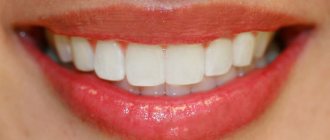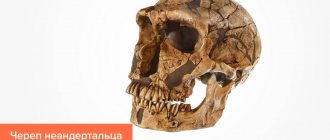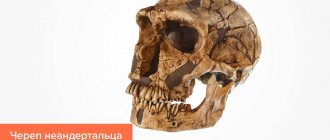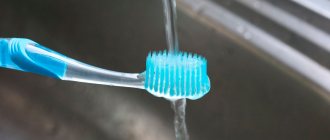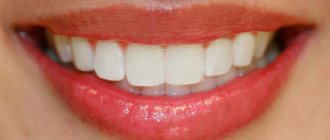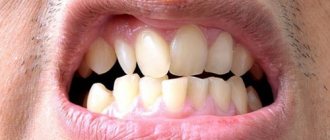21.11.2019
Children's baby teeth fall out and are replaced by permanent teeth. In rare cases, the first ones do not have time to fall out, but the second ones already grow nearby. This phenomenon received a specific name – “shark teeth”. Parents are always concerned about the question of what to do in such a situation.
Pathology mainly appears during the eruption of the lower central incisors. Less commonly, this happens with the growth of the upper incisors or molars.
Causes
A child's first teeth erupt in a certain order, starting at about six months of age. There are deviations in one direction or another, which is due to a number of factors (climate, drinking water) and the individual characteristics of the baby. For some, they appear as early as 1.5 months, for others - closer to a year. They fall out in the same sequence and are replaced with permanent ones. Complete replacement of the dentition occurs on average at the age of 12-13 years.
But there are also situations when permanent teeth begin to grow right next to the second row of milk teeth. If they are located in parallel, then this is called “shark teeth”. The name was coined by analogy with the anatomical feature of sharks. These predators have teeth arranged in three rows.
Possible reasons:
- genetics;
- improper formation of tooth germs during intrauterine development;
- rickets;
- infectious diseases (sinusitis, tonsillitis, adenoiditis).
Possible consequences
The appearance of the second row leads to serious negative consequences for the oral cavity and dentofacial apparatus. Among them:
- violation of diction;
- poor chewing of food with subsequent indigestion;
- curvature of the roots of neighboring elements, their displacement from their “rightful” place;
- change in bite;
- formation of trema and diastemas.
What devices are used to prevent malocclusion in modern orthodontics.
In this publication, we will look at the main signs of Costen syndrome.
Here https://orto-info.ru/zubocheliustnye-anomalii/okklyuzii/vliyaet-li-soska-na-prikus.html we’ll figure out whether the pacifier affects the child’s bite.
Why is it dangerous?
Despite the unattractive appearance of such a smile, there is no need to worry. Most often, dentists advise not to take any action. The root of the baby tooth softens, and the tooth falls out on its own after a certain period of time. The child facilitates this by loosening the tooth with his tongue or hands.
Despite the unattractive appearance of such a smile, there is no need to worry. Most often, dentists advise not to take any action. The root of the baby tooth softens, and the tooth falls out on its own after a certain period of time. The child facilitates this by loosening the tooth with his tongue or hands.
Treatment of polyodontia
The treatment method for shark teeth or hyperdontia depends on the person’s age and the degree of manifestation of the pathology.
If there is a delay in the elements of the temporary dentition, they urgently need to be removed. The procedure is not difficult. The wound heals quickly. If excess “shark” tooth germs appear, they are also removed.
In an adult, treatment is more difficult. More often, hyperdontia in such patients is accompanied by dental disorders that require treatment by an orthodontist.
How to relieve teething symptoms
When shark teeth erupt, pain and an inflammatory reaction appear. They can be removed with the help of medications. For this purpose, painkillers and non-steroidal anti-inflammatory drugs are used. They will reduce overall body temperature and relieve pain.
Adults can take tablets, and children are prescribed suppositories.
During this period, various gels are also used. They relieve pain and inflammation. They can be used from 3 months.
Shark teeth removal
Before removal, the person must take a panoramic X-ray. The dentist will evaluate:
- location of supernumerary units;
- structure of the dentition;
- size and number of roots.
After diagnosing polyodontia, surgery is prescribed to remove excess dental elements.
If there is one “shark” element in the mouth and there is good access for the surgeon, the operation is performed according to the standard method.
For large polyodontia and complex surgical access, the following procedures are performed:
- Pain relief with medications.
- Making an incision in the gum mucosa.
- Cutting the crown into fragments (if it is large). The main thing is not to injure the edges of the hole.
- Loosening by elevators.
- Delete.
- Treatment of the inflammation zone with antiseptics.
- Applying sutures and bandages.
Antibiotics and drugs to relieve inflammation are prescribed. It is necessary to examine the doctor according to the schedule and follow all his recommendations.
Orthodontic treatment of supernumerary teeth
After removing the shark teeth, they move on to straightening the dentition. This is done for children using special plates. They are made individually based on an impression of the jaw.
With a permanent dentition, to eliminate the consequences of polyodontia, a person is given braces. The bite is aligned to:
- there was an even load when chewing;
- the correct closure of the upper and lower jaw has been formed;
- diction and appearance improved.
The importance of proper breathing
Nasal breathing helps the jaws develop anatomically correctly. If you breathe through your mouth, there is a high risk of their underdevelopment. This fact can easily be explained by the fact that the tongue plays an important role in the formation of the jaws. In the first case, he takes the desired position. In the second case, the tongue is located at the bottom of the oral cavity and practically does not come into contact with the elements of the jaw arches. They do not develop properly and there is not enough space for permanent teeth.
The parents' job is to closely monitor their child's breathing. If nasal breathing is impaired during colds, a quick solution to the problem is required.
Concomitant pathologies
As already noted, the appearance of an anomaly is caused by a violation of embryogenesis and/or development of the child’s dental apparatus after birth.
The human body generates two types of teeth – primary and permanent. The first, 20 pieces, function from 2 to 6 years. Their replacement with permanent elements occurs in the period from 6 to 13-14 years.
By one year, the crowns of the “milk jugs” complete their formation and stop growing. The continued development of the jaws leads to the appearance of interdental spaces - diastemas and three.
The phenomenon does not relate to pathology, and disappears during the period of completion of the formation of the permanent occlusion. If a child aged 2-6 years does not develop interdental gaps, this indicates an abnormality in the development of the jaws.
The change occurs as a result of a certain biochemical process - resorption. The resorbing system, consisting of lymphocytes, osteoclasts and connective tissue, takes part in the resorption of “milk jugs”. The main role is played by osteoclasts - destructive cells that dissolve bone tissue.
At the beginning, the partitions between the roots of milk teeth and the rudiments of permanent teeth dissolve. Then the destruction of their roots begins in the area of contact with the coronal part of the growing permanent units. As the roots reabsorb, baby teeth become increasingly mobile and eventually fall out.
If the permanent tooth germ is located not under the milk tooth, but with a displacement to the side, the resorption process is disrupted. The “milk jug” maintains a strong connection with the alveolar process, preventing the growth of permanent teeth. And he has no choice but to grow up in the wrong place for him, in the second row.
Thus, the late loss of "milk jugs" leads to the fact that the permanent units that should take their place can only erupt by moving to the side.
The small size of the jaw, due to its underdevelopment, also leads to the fact that there is not enough space for permanent teeth; they either crowd together or are located in the second row.
Overnumeration is a case when the number of teeth exceeds the required 32 units. This is a relatively rare abnormality, occurring in 2% of people. Men are susceptible to pathology more often than women.
Extra molars and canines are usually generated. Even with normal jaw parameters, there is no room for “extra” teeth, and they are forced to form a second row.
Prevention
There is no such prevention that guarantees 100% prevention of anomalies in children. But there are several rules to help reduce risks. Here is their list
- Establishing proper nutrition with sufficient amounts of all vitamins and microelements. There should be solid foods that train the dentofacial apparatus.
- Timely treatment of oral diseases. Carious processes often lead to disruption of the development of the dental system.
- Correct nasal breathing.
- Regular visits to the dentist for preventive examinations and identification of possible problems.
If, when shark teeth appear in a child, the doctor advises removing a temporary tooth, do not be afraid of this. Modern dentists perform this procedure only when indicated and absolutely painlessly.
Underdevelopment of the jaw rows
The appearance of “shark teeth” with micrognathia is a complex pathology that requires long-term treatment of six months or more. For correction, removable and non-removable orthodontic appliances are used, the choice of which and the timing of wearing depend on the condition of the oral cavity and the severity of the anomaly. It is recommended to start treatment in childhood, when bones are more susceptible to external influences. But for a child, wearing a device is associated with such difficulties as proper care and brushing of teeth; it is necessary to adhere to the therapy regimen. Invisaligns made in the form of elastic aligners made of polymer show good results. They are removed during meals and hygiene procedures, and are hardly noticeable during conversation. But they can only be used if the defect is mild.
Reviews
Various dental anomalies have a negative impact on the beauty of a smile.
Defects create obstacles to communication and provoke a person to develop a subjective and distorted opinion about his appearance, as a result of which he begins to experience deep emotional stress.
Shark teeth, malocclusion, and diction problems can also lead to such consequences.
If you have already encountered such a problem, and after reading the article you would like to share with readers an effective way to eliminate the anomaly, leave your feedback in the comments below.
If you find an error, please select a piece of text and press Ctrl+Enter.
Tags: bite correction
Did you like the article? stay tuned
Previous article
When subperiosteal implants are the only option to restore the integrity of the dentition
Next article
Technology of restoration of teeth in the frontal zone with glass-ceramic crowns
Should I worry?
Usually there is nothing wrong with this happening. Quite quickly the root becomes soft and loose, and the tooth itself begins to wobble and soon falls out. Children usually actively participate in this process, constantly shaking the “unnecessary” tooth with their hands or tongue. Then the permanent one settles in the vacant space.
But it happens that the root of a temporary tooth turns out to be strong, slowly dissolves, and the permanent one grows even before the temporary one falls out.
Then the permanent tooth grows incorrectly, since its place is filled, and it has to be placed in front or behind the milk tooth. During the periods of six and eleven years there is the greatest risk for the appearance of this pathology.
After all, at the age of 6, the front teeth change, and at the age of 11, all the remaining permanent teeth grow very actively. Most often, shark teeth are formed at the time of eruption of the lower incisors, but occasionally this occurs during the growth of molars.
Main features
The disease has severe symptoms. However, signs may differ between children and adults. Polyodontia in adults is manifested by the following symptoms:
- Excess teeth appear on the palate and gums. Their structure and shape are distorted.
- Occlusion disorders.
- Problems with pronunciation.
- Turning the teeth from the main set to the side.
- Too close placement of dental elements to each other.
- Difficulty in chewing food and, as a result, disruption of the gastrointestinal tract.
- Inflammation of mucous structures due to injury to them by “extra” elements.
Children may develop additional baby teeth in infancy or from the first day of life. The symptoms are as follows:
- disruption of the eating process - the child constantly bites the mother, which makes breastfeeding impossible;
- disruptions in the functioning of the digestive system;
- swelling of the nasal mucosa;
- increased salivation;
- negative changes in body temperature;
- swelling of the tissues surrounding the erupting tooth.
Remember! The child most acutely perceives not speech problems that arise as a result of the disease, but ridicule from peers, which becomes a consequence of serious mental disorders.
Closedness and reluctance to behave openly in the presence of strangers can result in the child developing a sense of inferiority. For this reason, the anomaly requires immediate elimination using an individual approach.
Therapeutic measures
In order to prevent the development of a shark jaw in time and not to miss the stages of the formation of “extra” units, it is necessary to constantly monitor the condition of the dental system during the period of changing the milk set to a permanent one.
The child may complain of pain in the mouth and discomfort when biting into hard foods. It is important not to ignore these seemingly harmless signs.
It is necessary to evaluate the baby’s smile - if by the age of 5 years sufficiently wide gaps have not formed between his front teeth, this may threaten a further narrowing of the dentition. This phenomenon almost always entails the appearance of supernumerary units or contributes to the curvature of the indigenous organs.
The anomaly is treated in various ways. The technique is determined taking into account concomitant pathologies and the complexity of a particular case.
First of all, the doctor assesses the location of problematic baby teeth and removes them. This will allow timely normalization of the development of indigenous elements. As a rule, after such manipulations the problem is eliminated.
Further, during the life of the child, the dentition self-regulates to a normal state. This occurs under the influence of the lips and tongue, which, in constant contact with the crooked row, force the teeth into the optimal position.
If self-regulation is impossible, and the pathology has reached the stage of active development, doctors recommend orthodontic treatment , which consists of wearing braces or mouth guards. The design will have an impact on the teeth for a long time, gradually shifting them to the optimal position.
As for preventive measures, they do not exist, especially if you had to deal with an unfavorable genetic predisposition.
There are no preventative procedures that would 100% protect a person from developing a shark jaw. However, doctors give some recommendations, compliance with which will reduce the risk of anomaly:
- the child should regularly eat solid foods, which will help the milk elements fall out in a timely manner;
- Problems that arise in the baby’s oral cavity must be eliminated at the stage of their early development.
We will consider medical recommendations in more detail at the end of the article.
Despite the fact that shark teeth are rare, in 80% of cases this pathology is harmless and can be easily corrected. The main thing is to notice the problem in time and hurry to eliminate it.
“Shark” teeth in children: what to do if the teeth grow in two rows
The dentist explained why children sometimes grow permanent teeth ahead of time and how this is affected by the fact that the child breathes through his mouth all the time.
All parents know that over time, baby teeth must be replaced by permanent ones. But sometimes, looking into the child’s mouth, mom or dad discovers that they are growing second in line. This frightens many people: why did the teeth grow like that? Is this really irreparable? Perhaps this is dangerous to health? And what will be the consequences?
“Letidor” turned to Marina Kolesnichenko, dentist-therapist, chief doctor of the Beauty Line clinic. The doctor hastened to reassure the parents: nothing fatal was happening. But parents should still know why the “shark row” occurs and how to deal with it.
What should parents do?
Despite their frightening appearance, shark teeth very rarely lead to serious problems. Experts usually advise parents to wait until the baby tooth, which forms the second row, falls out on its own.
If this process is delayed, an orthodontist or dentist may recommend removal of a temporary tooth as an unnecessary vestige. After this, after some time (several months or weeks), the permanent tooth occupies the desired hole and is fixed in it.
In what cases should you contact a dentist:
- if 3 months after the appearance of a permanent tooth, the temporary one still has not fallen out;
- if a non-permanent tooth is quite loose, but does not fall out on its own, causing pain and anxiety to the baby, or even loss of appetite;
- if the temporary tooth begins to become inflamed, which can be judged by pain, discoloration, and “spotting” of the enamel;
You should not delay the process of seeing a doctor if changing teeth is associated with pain and suffering for the child. How can you help your child if the temporary tooth has not yet fallen out when the permanent one has already begun to grow, which leads to gum pain?
